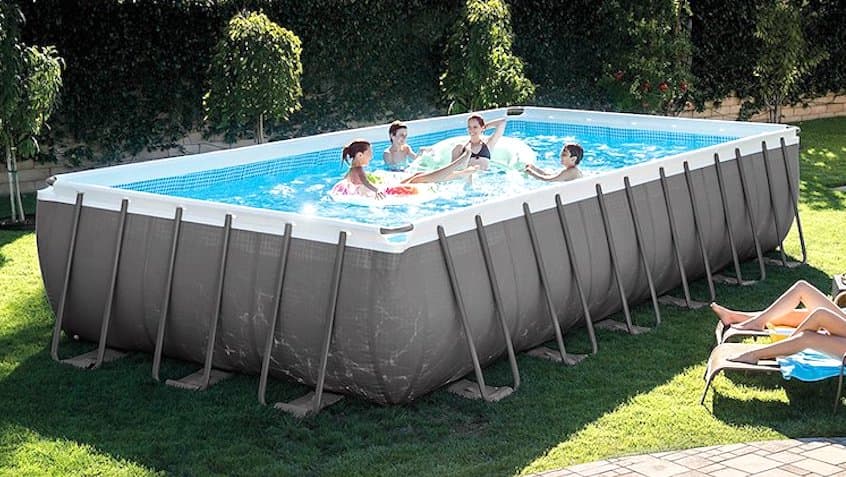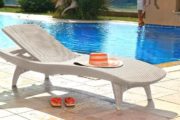This independent website is funded by its readers. It can earn a commission on any purchases made through product links, at no extra cost to the buyer. Learn more >
They’re easy enough to fill but when it comes time to drain an above ground pool then a little advanced planning and preparation is required.
Our experts are going to take a walk through of the whole process of pre-planning, and then take a look at a couple of methods of draining the pool. Pool size can determine the method of discharging the pool water, and the whole process can take as little as an hour of two or up to three to four days.
Let’s find out about the best methods and the best practices to use……
How To Drain An Above Ground Pool
Where To Discharge The Water To
This of course is fundamental, and the type of pool sanitisation you’re using will dictate where the water will be evacuated to.
Each county or state has it’s own particular recommendations for this, so we are going to look at the general principles that guide most states. We definitely recommend you check out your own states codes of practice for draining above ground pools.
So there are two main types of pool sanitisation systems, salt water or chlorine based and each has it’s own water disposal protocols. Lets take a look at what we need to consider…..
Draining a Chlorinated Pool
The first step here is to test the water and note the chlorine content and PH values. What we need to do is reduce the chlorine levels to around 0.1mg/L. This can be achieved in a couple of ways. The pool can simply be left untreated for between 7 and 14 days and the chlorine content will naturally reduce on its own.
A second method which many above ground pool owners prefer to choose is treating the pool with a de-chlorinator which can bring the levels down in hours rather than days and weeks.
- ✔️ TECHNICAL-GRADE CHLORINE REDUCER will interact with chlorine and bromine from residential water. That annoying chlorine scent in your swimming pool, pond, aquarium or fish tank will be gone in no time!
- ✔️BANG-FOR-YOUR-BUCK POOL CHLORINE BALANCE : Our multipurpose chlorine stabilizer comes in a sturdy 10-lbs package, which is reusable, easy-to-use, and budget-friendly. No need to buy costly pool-specific de-chlorinators.
- ✔️ 1 CHLORINE REDUCER, 100+1 DIFFERENT USES: The Cesco Solutions sodium thiosulfate can be used as a spa chlorine balancer, a chlorine reducer for swimming pools, pond dechlorinator, or a photographic fixer.
With our chlorine levels down to barely detectable levels and PH level between 6.5 and 8.5 we’re in good shape to start dumping the pool water.
Where To Discharge Chlorinated Pool Water
Even though the water has been de-chlorinated it shouldn’t be discharged into storm drains, it will still contain trace chemicals that could find there way into your rivers and streams. Most states allow treated pool water to be evacuated into the sanitary sewer systems though, and that’s the best route for it.
If you are draining a large pool then you might also consider pumping it out during “ off peak “ times like afternoon of overnight to avoid overwhelming your local sewer system.
Not every pool is located with easy access to the sewer system so of course in this case the water needs to be rum off locally. Whilst smaller pools don’t present a problem some larger above ground pools contain upwards of 15000 gallons and might need emptying over several days or longer to avoid water logging the ground.
Draining a Salt Water Pool
Salt water above ground pools need a slightly different and less flexible approach to draining.
Because of the high sodium content salt water will damage grasses and plants and even affect some tree species too, so just draining the pool into to your yard or garden is probably not going to be an option. In addition salt can stay in your soil for many years especially in drier states.
Where To Discharge Salt Pool Water
Salt water from the pool must not be run into the storm drains around your property which pretty much just leaves one simple option, that’s the sanitary sewer connections in your home.
If this is not an option then a licensed sewage handling service should be able to handle the “contaminated” pool water for you. If your home has a septic tank then you’re pretty much just left with this option.
Techniques To Drain Your Pool
Just two main methods here, either siphoning or pumping out the water.
Siphoning
This tried and tested method will work up to a point, it won’t drain all the water from the pool and as the water level in the pool decreases so does the speed of the water being siphoned out.
It can take a day or longer with larger pools and you¡’ll typically be left with a foot or two of water left to bale out. Siphoning may be an option on smaller plunge pools but it’s pretty unsatisfactory on above ground swimming pools.
If you want to try it then the easiest way to start the process is to simply start to fill the pool with your water hose then turn off the tap and disconnect the hose from the tap. If the the tap is lower than the pool water level then it’ll start to naturally siphon out.
Of course the problem here is the water is going to evacuate in an uncontrolled manner around the tap area which in most cases is a pretty sub optimum solution.
If you are planning to run off the pool water on to your property then adding another couple of siphon hoses into the pool will speed up the process and help spread the water.
Pumping
Of course this is the way to go, especially for larger above ground pool installations. It allows faster draining and should be able suck out all but an inch or two of water.
- Extracts water down to 1/4" depth for efficient water removal with 1/4 HP at 1500 GPH (gallons per hour)
- Multi-connection adapter, including garden hose compatibility for versatile use
This method also allows you to easily direct the water to a remote sanitary sewer system for disposal.
Keep in mind when you are buying or renting a submersible pump where it’s going to pump the water to.
You don’t need a pump with a massive output if it is pumping into a domestic 1.5 inch plumbing system which typically has a maximum flow rate of 35 GPM or 2100 GPH. If you’re going into a 4.00 inch system then you’re looking at 240 GPM or 14400 GPH.
If you don’t want to mop and bale out the last of the pool water then a wet and dry vacuum will take care of the job in minutes instead of tedious hours.
- 【STANLEY BRAND】STANLEY is a well-known brand that focuses on R & D, production and sales of vacuum cleaners. In addition, STANLEY is the recognized world leader in wet/dry vacuum cleaners. Since 1843, we have produced innovative, high quality vacuum cleaners, hose, filters, bags, and other accessories
Recommended Reading
Images from Amazon Product Advertising










